 Stryd vs Stryd – Some Data Comparisons
Stryd vs Stryd – Some Data Comparisons
Must Read: in-depth Stryd Review
I’ve noticed some anomalies with the new Stryd footpod over the last few weeks. Here they are and please feel free to share your results, comments or criticisms below.
Tests – What I Did
This article has the results from 3 different run types over varying speeds and mostly on flat, hard terrain on near-windless days.
Two of the tests have an Old Wind Stryd on one foot and the latest Stryd on the other foot…swapped over at the halfway point. Both were on Nike Vaporfly shoes using the exact same calibration parameters albeit the distance factor was measured on a running track on different shoes.
The third test uses both Stryds on one foot and also enables autocalibration for each device at the start of the run. Both the Stryd pods are on my weaker right side…two pods on one shoe is not the best mounting position as the pods might touch and the Vaporfly laces point in a weird direction at the best of times. Be that as it may, very similar results carry over from the first two tests to this third test.
Distance
I am not concerned with the differences in the recorded distance in the first two tests. These differences are easily explainable by changing pods from one foot to the other and by using a manual calibration factor determined a few weeks ago on an entirely different pair of shoes.
The third image shows the run where the two Stryds are autocalibrating to distance. There’s a slight overall discrepancy and again I’m not overly concerned with that for this test as I was aiming to look here at how the recorded pace changed throughout the calibration process.
At the end of the 3rd test, the calibration factor on one device was unchanged and the other had changed by 0.1 (I can’t remember which)
Pace
As we would expect, similar distance measurements equate to similar speeds. The old Stryd is coming in a tad faster but this is not significant. They are close enough for this test.


Vertical Oscillation
Clearly, something has changed when we look at the Vertical Oscillation calculations between the two different Stryd models. Either model is plausibly correct and, although I haven’t shown it, neither ties in with the VO from the Garmin HRM-PRO strap. IDK which is correct.
The point is that New Stryd shows a notably increased Vertical Oscillation and I wasn’t expecting that.
I’m not especially concerned about the VO metric.
However, could something have changed in the sensor management that causes the difference? Vertical movement (though perhaps not this metric per se) must be a factor in Stryd’s power calculation. Maybe the higher VO taken into account in a new algorithm. IDK
Stance Time (Ground Contact Time, GCT)
My GCT is lower with the new pod. Again, I wasn’t expecting this and the results are consistent when I switch pods on my feet and when the pods on are the same foot.
Perhaps this is linked to the change in VO from the previous section.
Power
So now we come to the important running power metric. Stryd claims that the new power metric is more responsive than before due to more frequent data points. Fair enough. I was also under the impression that this only impacted sprinting speeds.
In these tests, I wouldn’t classify any speeds as sprinting. I think the first test was the slowest at 4:20/km or something like that.
With 20-second power smoothing, the new Stryd power is clearly higher. I’d guestimate it to often be 5% higher.
Air Power
Air power is a constituent of total power.
In these tests, there was effectively no wind. Yet the new Stryd reports notable Air Power.
If you told me that the old Stryd’s air power was the extra power required to overcome the wind, I’d believe you. It’s mostly recorded as zero so that would make sense.
If you told me the new Stryd air power is the extra power required to both overcome wind AND move your body through the air then, again, I’d believe you. But the thing here is that something has changed and I wasn’t expecting that.
Maybe my original Stryd pod has a faulty air pressure sensor? I did check that the hole wasn’t clogged up and washed it. I did check that the new and old cradles were compatible with the hole position on each Stryd pod and they seemed to be identically placed.
Conclusion
I am aware that other early adopters of the new pod have noticed differences in air power.
I don’t quite know what to make of these results and I reached out to Stryd for comment a while back.
I could be wrong but it looks like the impact of both the movement sensor and air pressure sensor has changed between models. Furthermore, the running dynamics metrics and the power metrics are impacted by some changes.
I don’t especially care about the efficiency metrics and the speed/distance metrics look as correct as they always were. However, I don’t see why power has changed so much. If it’s because Stryd has a better way of measuring air power…great, say so. No competitor measures air power so what Stryd gives here is a bonus.
So. What I said in this link probably isn’t quite right.
the Stryd Next Gen pod for 2023 – What’s New In the Running Power ⚡ Model?
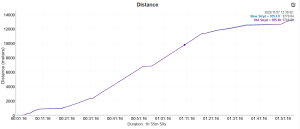

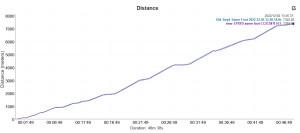
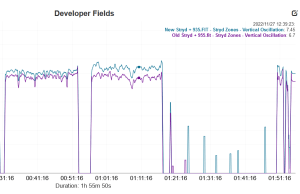
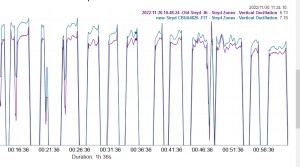

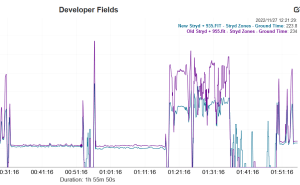

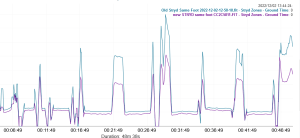
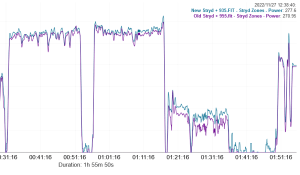



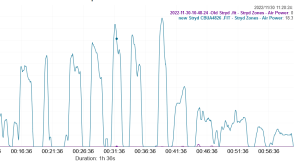


I’ve spent the last 3-5yrs building a relationship between power, pace and effort.
With this new Stryd I’m having to relearn that. That’s frustrating, even if on paper this is a better product, I wasn’t quite prepared for the level of power change it’s given. I thought like you it was meant to only change ‘sprint’ power.
I’ll get over it soon enough. Then might even say it’s a better Stryd in 3months time.
Old dog, new tricks, syndrome.
If the new pod results are really a better reflection of reality, one would expect they would adjust the old pod algos with the better ones.
However, I could guess maybe they don’t want to, to avoid support calls when existing users see a jump in their results, even if the changed results are “better”.
I recall asking stryd when the air pod was released whether it would give the same results as the nonair pod on a treadmill, thinking I may get the new one for trail runs and leave the old one on my treadmill shoes, but they said the results would not match in zero wind conditions, similar to what you found with the newest pods.
I can only assume they again didn’t update the gen1 pods with the gen2 algos.
air power:
i’m assuming there is a better ‘air’ sensor, so the algos couldn’t be rolled back
even if they could be rolled back it would only be to the last version ie the only other one with air power.
treadmill: yes, i can never quite get my head around the logic of that. you are still moving your body through the air. even if there is no wind there is air resistance associated with whatever speed you are moving at and the air density.
Is air resistance on a treadmill the same as outdoors?
Outdoors the whole body is moving at near uniform speed forwards.
Indoors, the upper body is only moving forwards and backwards by small amounts.
That’s my interpretation of the physics.
the foot movement on a treadmill should be the same or similar to the outside though, right?
and for the new pod, the foot motion is all the sensors have.
therefore it should report treadmill air power (incorrectly so). it will (maybe correctly) estimate the air power for moving the feet through the air and incorrectly extrapolate that for the full body.?
Yes I see your point. I still feel the same. I’ll try to explain.
Foot motion relative to upper body is the same whether indoors or outdoors.
Outdoors the upper body is moving forwards. So are the feet too, of courses.
So the foot velocity has two components. 1. Whole body moving forwards 2. Foot swinging forwards and backwards.
Outdoors is 1+2
Indoor is only 2
yes
but stryd will always report 1+2 ?
The pressure sensor always reports the pressure it sees, for sure. My point is that I believe that pressure is different for indoors and outdoors.
if you hold a pendulum in your hands and swing it. That’s an analogy for your legs running indoors. The pendulum sees a small amount of air pressure as it oscillates forwards and backwards.
Take that same pendulum, but this time run forwards with it in your hands. Now the pendulum has additional air pressure. The air pressure it previously had by oscillation, plus the air pressure by it moving forwards in space.
oh
i dont know about that. maybe, it doesn’t sound quite right to me tho. has someone said that’s correct?
i was talking about the power to overcome air resistance from the torso. which would be zero inside but significant outside.
Have found this:
https://storage.googleapis.com/stryd_static_assets/white_papers/wind-white-paper-8-17.pdf
“Q: How does Stryd work on a treadmill?
A: Stryd will give accurate values both indoors or outdoors, on or off the treadmill. Since
on a treadmill you are running in place, there is no air resistance to overcome. Stryd will
naturally measure a lack of air resistance and your power will accurately reflect it as such.”
yes that’s the old stryd, which the results above would suggest would have a near zero or zero air power (probably correct)
newest stryd would (incorrectly) report air power on treadmill, no?
i guess there’s one way to tell…
Yes I see what you’re saying.
It is incorrect for Next Gen to report air power indoors, which some users have shown.
I think they’ve made the sensor’s signal processing so sensitive to correct issues with Nike offset laces, that they’ve adjusted up the air power for everyone one else, to the extent of incorrectly showing air power indoors. (My baseless theory)
i have the nike offset laces, now i just need a treadmill
I’ll ask Gus on the FB forum